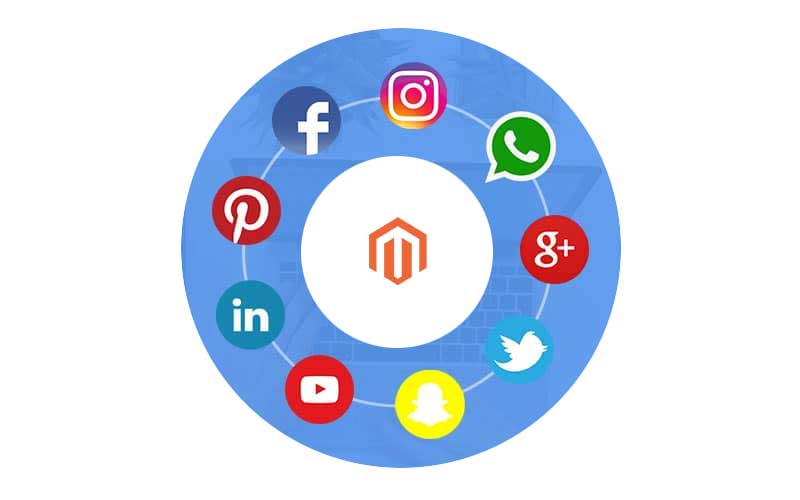
We have seen a huge growth in social media platform since last two decades. You can find people of almost every age group on social media whether these are young children, adolescents or old people, almost everyone is having a presence on social media. It is a very easy medium to know what is happening in the lives of our kith and kin and get updates of the outer world as well. The most popular social media platforms in the world are Facebook, Instagram, Twitter, and Pinterest.
Do you know that an average person spends 43,800 hours on social media which is equivalent to 5 years?
Well, social media is not only connecting the people with the outer world but also opening up opportunities for online businesses as well. As shopping is also a social experience. People love to interact with the salesman, their friends or family while doing shopping. And do you know that every 9th person looks on social media for a better buying decision and almost 75% of the online buyers bought an item as they have seen it on social media?
In this article, you will come to know about all the aspects of social commerce, there benefits as well as the new trends in social commerce.
What is Social Commerce?
Social Commerce is the amalgam of social media and e-commerce. When a seller sell products on social media and a customer buy it from there, then this whole process is termed as social commerce. There are many different ways of selling products on social media and can be done wholly or partially. However, one should remember that on social media, products are getting sold by the online retailers present on them, not by the platform itself. Mostly Social commerce comprises global or local marketplaces which include huge businesses selling millions of products to their social media followers. Activities can include various aspects of e-commerce from learning about a product through direct messages to sellers to making a mobile payment via a social app.
Some of the best examples of social commerce are:
- You must have seen Google Shopping Ads on YouTube
- Product Pins on Pinterest with prices
- Buyable product pins on Pinterest
- Chat boxes to know more about products or services
- Groups and Forums to purchase or sell items
- Facebook Marketplace where thousands of products are sell and purchase locally
- Product Promotions by e-commerce sites on Instagram
Social Commerce Market Statistics
Social commerce is not just limited to a string of popular buzzwords. It can really help you for popularizing your brand and create a fuzz about your products. Do you know that 80% of people who use the Internet do online shopping and there are more than 3.5 billion users of social media worldwide in 2019?
Other important stats are:
- 87% of online customers agree to the fact that social platforms help them for making a good purchasing decision.
- One-fourth of the e-commerce store owners are selling their products through the giant social media platform Facebook alone.
- 40% of the e-commerce merchants are leveraging social media for improving their annual sales.
- One-third of the customers agree to the fact that they do online shopping directly from the social media platform.
- Customers who want to know about the product you sell expect a reply from your team within 4 hours while 42% of these customers expect a reply with an hour and 32% within half an hour
- 74% of the online customer depends on social media platforms for their online shopping.
- 60% of SMBs say they’ve gained new customers through social media efforts.

Social Commerce Types:
You can find 5 different types of Social Commerce, these are:
1. Community-Driven Social Commerce:
In the community-driven social commerce, social media platforms are present for sharing the products, but not mandatorily for purchases. Facebook, Twitter, and Pinterest are the best examples of this type of social commerce. If your store is not present on a social media platform but still offers chatting or sharing features, then it will also be categorized as community-driven social commerce.
2. Platform-Driven Social Commerce:
Platform-driven social commerce is a platform which brings the online customers together for making a purchase, but an individual is doing the selling. You can sell your products on these platforms. The best examples of platform-driven social commerce are Etsy, devianART, eBay etc.
3. Group Driven Social Commerce:
Group driven social commerce is slightly driven then community-driven. In this approach, there are group members who don’t know each other but are ready to purchase items so that they will get a lower cost. Groupon is the best epitome of Group driven social commerce.
4. Peer Driven Social Commerce:
When the customers share what they have purchased online on their social network, then this is termed as peer-driven social commerce. It encourages their friends or family to buy the same item and give trust to them.
5. User-Driven Social Commerce:
E-commerce platforms which allow voting, feedback, recommendations, and creating the roster of those products which are liked by the customers are user-driven social commerce. Amazon is the best example of user-driven social commerce.
Popular Social Commerce Platforms:

You can find many social commerce platforms which are implementing e-commerce features and marketing features such as “buy buttons”, “know more buttons”, product pages, etc. You must hear about these popular social commerce platforms like Facebook, Instagram, Twitter, Pinterest, and Google. There are many features which are common in these platforms. We will be discussing each of these platforms in more detail.
1. Facebook:
Facebook, the world’s biggest social network platform has initiate building e-commerce shops within Facebook pages. It is testing a shopping method in which the user can buy items directly from the company’s Facebook pages. It is giving advantages to e-commerce by setting up a mini-store on its platform.
Facebook wants to give a complete shopping experience to the users from product discovery to checkout. On mobile, you can see the shopping features in a new “shopping” section on the page, while there would be a separate tab on the desktop. The shopping section would be almost similar to the Facebook news feed pages.
If a user needs to purchase a product, then the company can either choose to give purchase functionality on Facebook or redirect to the company’s website.
2. Instagram:
Instagram is another social media platform in which companies are leveraging for social commerce. It is widely popular for sharing photos or small videos on its platform. Companies can share the attractive images of their products on their platform with the “Shop Now” button. Instagram introduced this shopping feature on its platform in 2016. There are more than 300 million users on Instagram.
There is an “action-oriented advertisement” on Instagram which appears below an image. These action-oriented buttons can be of installing an application, buy a product, or sign-up for a service. Earlier the buttons with a single photo but now they are with a carousel. Businesses are opting for Instagram because the major proportion of the users discover new products on Instagram, and among them, nearly three-fourths take action after seeing the post. Also, 80% of the Instagram users follow at least one brand on it. Instead, photo and video posts link out to a website, adding an extra step and making the experience a little less slick than Facebook’s version.
3. Twitter:
Nearly five years ago, Twitter tested his first e-commerce product. Twitter featured a “Buy button”, which lead the users to buy a product directly from the Tweet. The intention of Twitter was to implement functionality on its platform to make shopping from mobile devices convenient and easy. Companies can share the product details, provide offers on their merchandise and the users can react on those posts on Twitter apps of iOS and Android.
After clicking on the “Buy” button, the user will get additional details of products and then prompted for shipping and payment information. Once that’s entered and confirmed, your order information is sent to the merchant for delivery.
4. Google:
If you will search a product such as “Nike Shoes” on Google then you may find shopping ads of different companies on Google search page, with “Buy on Google” text. On clicking the ad, the user would be redirected to retailer-branded product page hosted by Google. Checkout is simple, seamless, and secure, provided you have saved payment credentials in the Google account.
Also, Google is working with the major e-commerce retailers such as Amazon, Flipkart, etc to add deep links to their website or apps in their shopping ads.
5. Pinterest:
You can find “buyable pin” which will let you buy item anything that you see on Pinterest. These buttons are blue in colour and are just beside the red pins. You can find the buyable pins on Pinterest. For e.g., if you searched for “blue jacket” on Pinterest and then click on “see more” button at the top right corner, it will show a number of jacket options. On clicking “$” sign, you would be able to set a price limit by scrolling. After setting a range you can find jackets within that price.
If you are ready to purchase then you can make the payment using Apple Pay or Credit card. It will also store your card details for future transactions.
Why it is important to consider social commerce?

It is not hard to justify why social commerce is so important for your business. It will not only increase your sales but also enhance the branding of your business. Let’s know the reasons:
Social Visibility
When the user is not tech-savvy and a newcomer for e-commerce then he/she may find trust issue while buying on an e-commerce site. The user will have a hesitation to do online shopping when he is habitual of traditional shopping. But with social commerce, you can showcase the trust of other users on your brand which will give the user assurance of quality.
Authority
Authority doesn’t only relate to e-commerce in social media, but it shows you how contraction or expansion social networks around trends or events are taking shape. They invest time and money for earning a trust position which can help the community by providing proper recommendations.
Scarcity
In exclusive deals, customers are fear-driven of loss. But social commerce gives them the ability to check in advance about the deals, stay updated, and also gives access to discounts or offers.
Like
There is an adage “People prefer to do business with people they like”. And nothing is truer today than social media.
Consistency
When there is any doubt, the customer prefers traditional shopping from brick-and-mortar stores. But with social commerce, they get consistent information about the products on all platforms which built trust.
Top Social Commerce Trends:

In-app purchases:
There was a time when social media platforms were limited to share photos and videos, but they can also influence the user’s purchasing decisions.
As per Retail Dive report, nearly 75% of the users on Instagram get influenced by their purchasing decision. It is a significant percentage as the users buy from a social media platform when there is something enticing about the product.
The users can save time through in-app purchases. It also improves the number of impulse purchases. All major companies understand this thing that a customer’s mind can change in seconds. Hence companies are using in-app purchases for substantial sales.
Chatbots:
Chatbots have been in existence since a very long time, but they weren’t able to convert a visitor into a customer. A customer prefers to interact with a human than a chatbot. But now there has been a great evolution in chatbots due to Artificial intelligence. They have become almost identical to a social media person and can recommend products to the customer on the basis of their queries. This is useful to more than half of the online customers.
Messenger Marketing:
Ads on Facebook Messenger has improved its marketing. It hasn’t been a huge time since Facebook starts showing ads on its messenger. But, the e-commerce store owner didn’t make any delay to leverage this thing. There are more than 1.3 billion monthly users of Facebook messenger. Ads do not require an opt-in process as they reach directly to the inbox of the users. Also, the open rate of Facebook messenger rates is very high (98%).
Augmented Reality:
Augmented Reality is one of the most potent trend of social commerce. Brands are leveraging AR in many different ways to keep social media users hooked on their social apps. The common examples are Taco Bell with the Snapchat campaign or Webby Parkers which let you try on glasses using your phone.
Personalized Quizzes:
If you get a free meal, what will you prefer to eat? Chinese, Mexican or American?
It is highly likely that a user will answer such questions while seeing as a pop-up on an app. Simple quizzes are good pass time for users and many e-commerce brands using such quizzes to promote their brands or products.
Personalized quizzes help the brands to know about the preference of the customer and after all the questions they recommended products to the customer. This results in a high conversion rate.
Wrapping Up:
There are plenty of reasons to use social media for improving your brand visibility, get a portion of sales, and increase conversion rates. E-commerce is having a huge potential in future, and there are going to be many different types of trends. If you are planning to build an e-commerce store for your traditional business, then you must consult our team. And don’t hesitate in reach out to us if you wish to improve the features and functionality of your existing store. We can do everything in e-commerce.
KC Jagadeep, CEO of Ceymox, a leading Magento Development Agency based in India. KC is a passionate entrepreneur, Magento enthusiast, and advocate for open-source solutions, dedicated to enhancing the landscape of online commerce, particularly within the realm of Magento.Driven by the pursuit of creating and executing successful strategies and platforms for digital commerce, KC brings over 12 years of industry experience to the table. His mission is simple: to empower corporate eCommerce clients with effective digital commerce solutions and modern marketing practices, ultimately boosting profitability.As an entrepreneur with a proven track record in information technology and eCommerce services (including Magento and WooCommerce), KC possesses expertise in operations management, startups, various eCommerce platforms, and business process outsourcing.
View All Articles